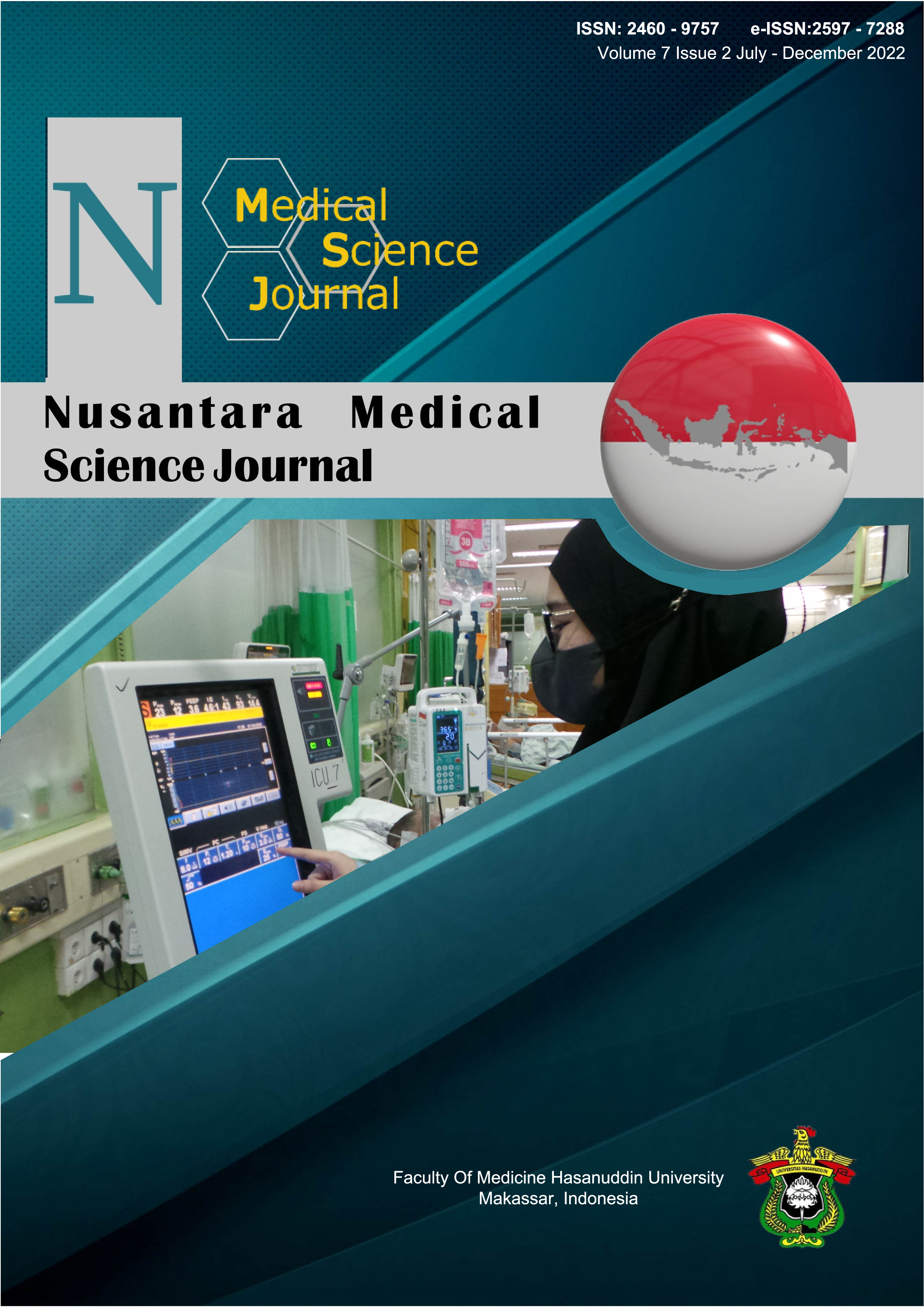The Association of Cumulative Fluid Balance and Sepsis Patient Mortality During Treatment in the Intensive Care Unit
DOI:
https://doi.org/10.20956/nmsj.v7i2.20229Abstract
Introduction: Fluid management in sepsis patients is crucial, especially in the first three hours after sepsis diagnosis is established. However, excessive fluid administration will increase patient mortality. This study’s purpose is to determine the correlation among cumulative fluid balance and mortality in patients with sepsis and/or septic shock admitted to the Intensive Care Unit (ICU) of Dr. Wahidin Sudirohusodo Central Hospital, Makassar. Methods: This comes about as an analytical observational study with a retrospective method. The population involved in this study was patients diagnosed with sepsis and septic shock who were treated in the ICU of Dr. Wahidin Sudirohusodo Central Hospital, Makassar from January to December 2021 with a total sample of 56 people. Data were analyzed using Mann-Whitney and Chi-Square statistical tests with a significance level of α=0.05. Data were studied using SPSS 25.0 (SPSS, Inc. Chicago, IL). Results: The mean cumulative fluid balance in septic patients was -1299.51±5228.34 ml. Based on the fluid balance category, 24 people (42.9%) had a positive balance and 32 people (57.1%) had a negative balance. There was a correlation among cumulative fluid balance and mortality in sepsis patients hospitalized in the ICU of Dr. Wahidin Sudirohusodo Central Hospital (p < 0.001), out of 24 patients with a positive balance, the non-survivors percentage was 66.7% and 33.3% of patients survived, while out of 32 patients with a negative balance, the percentage of non-survivors was 18.7% and 81.3% of patients survived. Conclusions: There is a correlation among cumulative fluid balance and mortality of septic patients in the ICU. A positive cumulative fluid balance will cause a higher mortality rate or risk of death compared to a negative cumulative fluid balance.
References
Singer M, Deutschman CS, Seymour CW, Shankar-Hari M, Annane D, Bauer M, et al. The Third International Consensus Definitions for Sepsis and Septic Shock (Sepsis-3). J Am Med Assoc [Internet]. 2016 Feb 23;315(8):801. Available from: http://jama.jamanetwork.com/article.aspx?doi=10.1001/jama.2016.0287
Rhodes A, Evans LE, Alhazzani W, Levy MM, Antonelli M, Ferrer R, et al. Surviving Sepsis Campaign: International Guidelines for Management of Sepsis and Septic Shock: 2016. Vol. 45, Critical Care Medicine. 2017. 486–552 p.
Levy MM, Evans LE, Rhodes A. The Surviving Sepsis Campaign Bundle: 2018 update. Intensive Care Med [Internet]. 2018;44(6):925–8. Available from: https://doi.org/10.1007/s00134-018-5085-0
Wulff A, Montag S, Marschollek M, Jack T. Clinical Decision-Support Systems for Detection of Systemic Inflammatory Response Syndrome, Sepsis, and Septic Shock in Critically Ill Patients: A Systematic Review. Methods Inf Med. 2019;58(6):E43–57.
Silversides JA, Major E, Ferguson AJ, Mann EE, McAuley DF, Marshall JC, et al. Conservative fluid management or deresuscitation for patients with sepsis or acute respiratory distress syndrome following the resuscitation phase of critical illness: a systematic review and meta-analysis. Intensive Care Med. 2017;43(2):155–70.
PRISM-Investigator, Rowan K, Angus D, Bailey M, Barnato A, Bellomo R, et al. Early, Goal-Directed Therapy for Septic Shock — A Patient-Level Meta-Analysis. N Engl J Med. 2017;376(23):2223–34.
Rivers E, Nguyen B, Havstad S, Ressler J, Muzzin A, Knoblich B, et al. Early goal-directed therapy in the treatment of severe sepsis and septic shock. N Engl J Med. 2001;345(19):1368–77.
ARISE-Investigator, Group ACT, Peake SL, Delaney A, Bailey M, Bellomo R, et al. Goal-Directed Resuscitation for Patients with Early Septic Shock. N Engl J Med. 2014;371(16):1496–506.
ProCESS-Investigators, Yealy DM, Kellum JA, Huang DT, Barnato AE, Weissfeld LA, et al. A randomized trial of protocol-based care for early septic shock. J Emerg Med. 2014;47(2):256–7.
Cordemans C, Laet I De, Regenmortel N Van, Schoonheydt K, Dits H, Malbrain ML, et al. Fluid management in critically ill patients: The role of extravascular lung water, Abdominal hypertension, Capillary leak, And fluid balance. Ann Intensive Care. 2017;2012(Suppl 1):18–23.
Sirvent JM, Ferri C, Baró A, Murcia C, Lorencio C. Fluid balance in sepsis and septic shock as a determining factor of mortality. Am J Emerg Med [Internet]. 2017;33(2):186–9. Available from: http://dx.doi.org/10.1016/j.ajem.2014.11.016
Brotfain E, Koyfman L, Toledano R, Borer A, Fucs L, Galante O, et al. Positive fluid balance as a major predictor of clinical outcome of patients with sepsis/septic shock after ICU discharge. Am J Emerg Med [Internet]. 2016;34(11):2122–6. Available from: http://dx.doi.org/10.1016/j.ajem.2016.07.058
Mitchell KH, Carlbom D, Caldwell E, Leary PJ, Himmelfarb J, Hough CL. Volume overload: Prevalence, risk factors, and functional outcome in survivors of septic shock. Ann Am Thorac Soc. 2017;12(12):1837–44.
Acheampong A, Vincent JL. A positive fluid balance is an independent prognostic factor in patients with sepsis. Crit Care [Internet]. 2015;19(1):1–7. Available from: http://dx.doi.org/10.1186/s13054-015-0970-1
Yoo MS, Zhu S, Lu Y, Greene JD, Hammer HL, Iberti CT, et al. Association of Positive Fluid Balance at Discharge after Sepsis Management with 30-Day Readmission. JAMA Netw Open. 2021;4(6):1–12.
Sujatha PP, Nileshwar A, Krishna HM, Prasad SS, Prabhu M, Kamath SU. Goal-Directed vs Traditional Approach to Intraoperative Fluid Therapy during Open Major Bowel Surgery: Is There a Difference? Anesthesiol Res Pract. 2019;2019.
Vaara ST, Korhonen AM, Kaukonen KM, Nisula S, Inkinen O, Hoppu S, et al. Fluid overload is associated with an increased risk for 90-day mortality in critically ill patients with renal replacement therapy: Data from the prospective FINNAKI study. Crit Care [Internet]. 2012;16(5):R197. Available from: http://ccforum.com/content/16/5/R197
Woodward CW, Lambert J, Ortiz-Soriano V, Li Y, Ruiz-Conejo M, Bissell BD, et al. Fluid overload associates with major adverse kidney events in critically ill patients with acute kidney injury requiring continuous renal replacement therapy. Crit Care Med. 2019;47(9):E753–60.
Venot M, Weis L, Clec’h C, Darmon M, Allaouchiche B, Goldgran-Tolédano D, et al. Acute kidney injury in severe sepsis and septic shock in patients with and without diabetes mellitus: A multicenter study. PLoS One. 2015;10(5):1–10.
Weiss SL, Peters MJ, Alhazzani W, Agus MSD, Flori HR, Inwald DP, et al. Surviving sepsis campaign international guidelines for the management of septic shock and sepsis-associated organ dysfunction in children. Vol. 46, Intensive Care Medicine. 2020. 10–67 p.
Downloads
Published
How to Cite
Issue
Section
License
Copyright (c) 2022 Nusantara Medical Science Journal

This work is licensed under a Creative Commons Attribution 4.0 International License.









